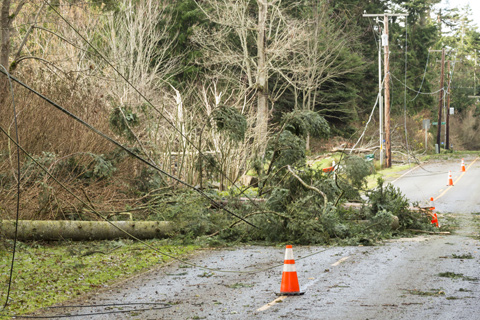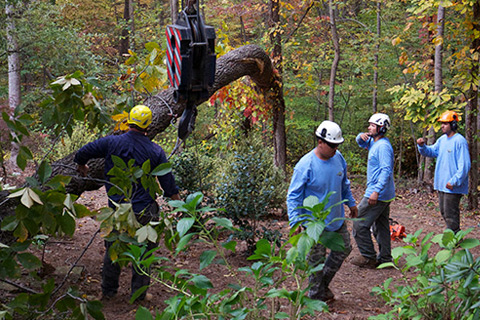
Whether you see trees interfering with power lines on your property or in the public right-of-way, it is important that you do not take matters into your own hands. When trees come in contact with power lines, they may break or bring the power lines crashing down. 72 Tree has seen this cause power outages in Alpharetta and notes these scenarios should be taken very seriously.
The trees are treated as seriously as the potential electrical hazard. The City of Alpharetta Tree Ordinance protects the city’s trees (both alive and dead) and imposes heavy fines for the unlawful cutting or removal of them.
Trees Interfering With Power Lines in the Public Right-of-Way
Alpharetta residents should report any tree on public property which poses a hazard to power lines by visiting Georgia Power or calling (888) 891-0938 and press option #2 – dangerous condition.
If storm-damaged limbs or a diseased tree has fallen and is obstructing the roadway, dial 9-1-1 (day or night) and provide as much information as possible for a swift and accurate response by emergency services. For occurrences in or on all other public property, contact the City of Alpharetta Arborist – David Shostak at (678) 297-6229.
Tree Branches Are Touching My Power Lines
When tree branches make contact with power lines, do not take any measures to correct the situation. Keep any and all ladders, equipment, and hands away from the tree and the power lines to avoid electrical shock.
In this situation, there are two options to safely have the situation mitigated:
Contact a tree professional properly licensed and trained to trim or cut the tree. Most professional tree services will make sure that the proper permits are acquired before starting any work.
Contact Georgia Power to advise of the tree and its potential danger. Georgia Power doesn’t attend to a single request on private property, typically they will cut and trim entire rows of trees. However, depending on the severity of the situation, they may respond or direct you to who can resolve the situation.
City of Alpharetta Ga Tree Ordinance
Specimen Trees – In the City of Alpharetta, specimen trees are provided special protection under the law. The damage, destruction or removal of these trees (dead or alive) without a permit may incur severe fines and penalties. There are also heavy replanting requirements when a specimen tree is lawfully removed. Contact the City arborist for further details regarding specimen trees at (678) 297-6229 or via email: treepermits@alpharetta.ga.us
Specimen tree size criteria is as follows:
Understory Trees – 8 inches DBH and greater
Overstory Trees – 24 inches DBH and greater
Pine Trees – 30 inches DBH and greater
DBH – “Diameter at Breast Height” is a standard measurement method of the diameter of the trunk of a standing tree. The diameter of the trunk is typically measured 4.5 feet above the ground (unless otherwise specified).
Tree Density Requirements – Tree density for single family residential property owners. The City of Alpharetta requires a minimum tree density on the property’s plantable area. Homes built prior to 1992, have a required minimum density of 20%. If built after 1992, a 30% minimum density is required.
For the determination of coverage for both understory and overstory trees, the City of Alpharetta provides a worksheet to accurately calculate the percentage. Questions on this matter should be directed to the City arborist at (678) 297-6229 or through email: treepermits@alpharetta.ga.us
For complete tree removal requirements in Alpharetta Ga, visit www.alpharetta.ga.us/government/departments/community-development/tree-removal
Seek Professional Advice Before Cutting or Trimming Your Tree
Before taking any action regarding trees in Alpharetta, seek the advice of an ISA Certified Arborist, tree cutting and removal service, or the City of Alpharetta’s Arborist Division. The potential cost of acting alone or out of haste is too great.
Always remember that when trees pose a hazard to life, taken down power lines, or have fallen and obstructed the road, stay clear of the affected area, do not drive over the power lines, and dial 9-1-1 for an immediate response.
This article was first published on: http://www.72tree.com/power-line-interfering-trees-city-alpharetta-ga-ordinance/










